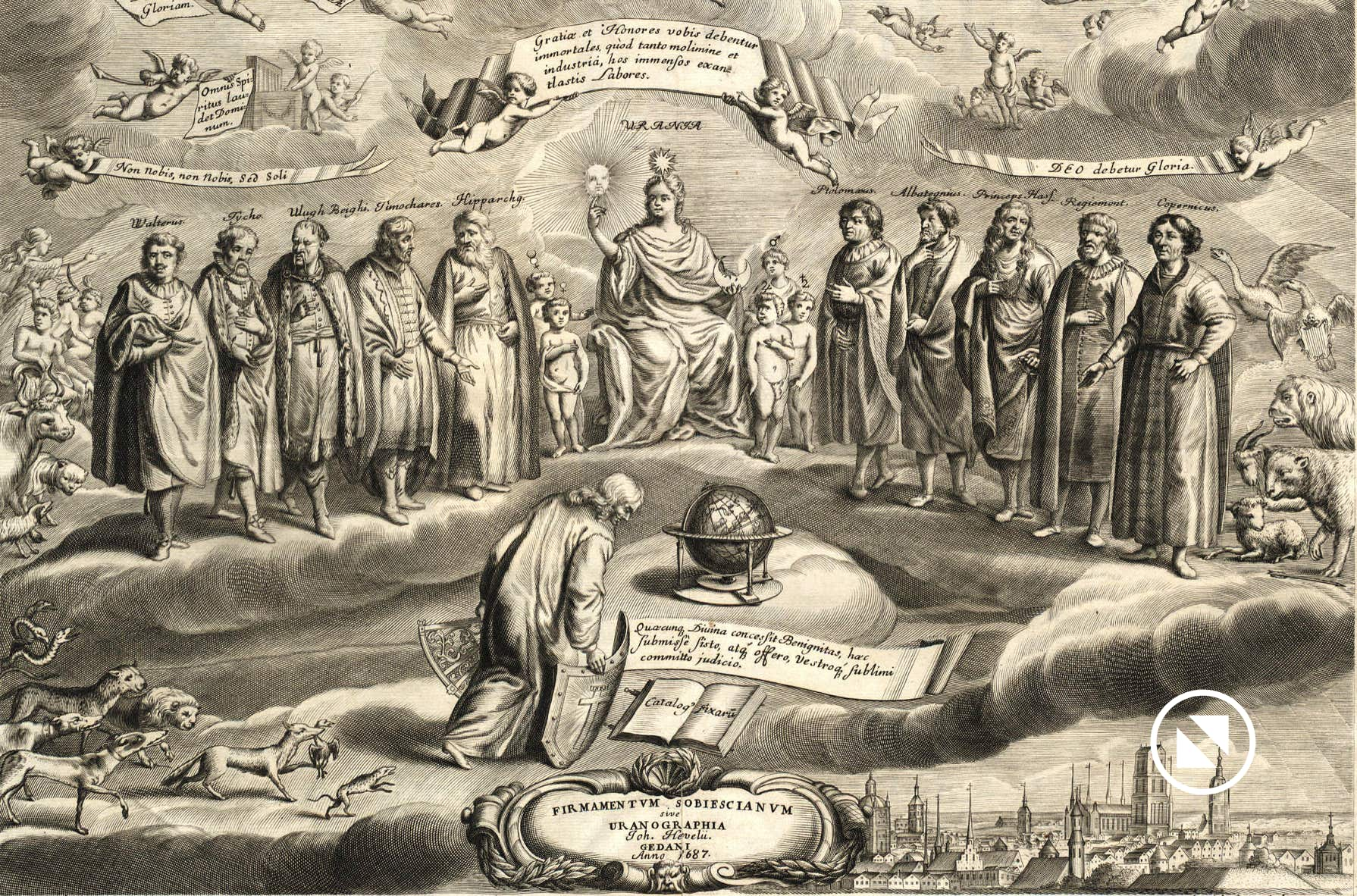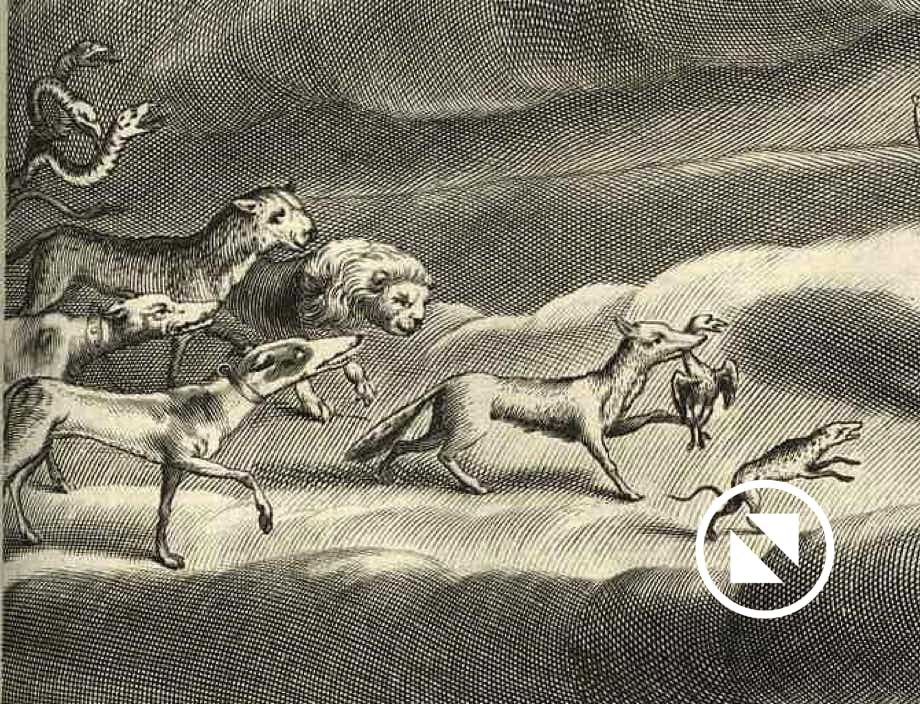Hevelius presents his new constellations
Johannes Hevelius (1611–87), centre foreground, bends his knee in supplication as he presents his new constellations for approval to Urania, the muse of astronomy, and an array of great astronomers of the past (see footnote). This engraving forms the frontispiece to Hevelius’s star atlas Firmamentum Sobiescianum dated 1687, the year of his death, but not published until 1690.
In his right hand Hevelius carries a shield, representing his new constellation Scutum, while in his left hand he carries his astronomical sextant, commemorated by Sextans. Behind him come his other constellations representing animals (see enlargement below), led by little Lacerta , the lizard. Following that is Vulpecula cum Anser, the fox and goose; the two hunting dogs, Canes Venatici; above them are Leo Minor and Lynx; and, at top left of this detail, is a three-headed snake representing Cerberus, the monster that guarded the gates of Hades. Cerberus was later dropped by astronomers, but the seven other constellations shown here remain in the sky. There is no sign in this illustration of two additional Hevelius inventions, Mons Maenalus (a subdivision of Boötes) and Triangulum Minus (a subdivision of Triangulum), both now obsolete.
In the wings of the main image are small representations of some existing constellations – Taurus with Canis Major and Minor on the left and, at right, Aries, Ursa Major, Capricornus, Leo, Lyra, and Cygnus.
Footnote: This judging panel of astronomical greats is arranged in roughly chronological order outwards from Urania. On the left (Urania’s right) are Hipparchus, Timocharis (who actually preceded Hipparchus and hence is out of order), Ulugh Beg, Tycho, and Bernhard Walther (‘Walterus’). On the right are Ptolemy, Albategnius, Wilhelm IV (the Landgrave of Hesse, here termed ‘Princeps Hass’), Regiomontanus, and Copernicus. The inclusion of Wilhelm IV might seem surprising, as he is much less well known today than the others, but in the 16th century he was a respected astronomer who compiled a notable star catalogue more accurate than Tycho’s. Hevelius reprinted the observations of Wilhelm in his own catalogue, along with those of Tycho, Riccioli, Ulugh Beg, and Ptolemy.
Six Hevelius constellations, seen in an enlargement from the lower left corner of the illustration above. At top left is the triple-headed Cerberus (now obsolete), with Lynx and the two dogs of Canes Venatici below it. Ahead of Lynx is Leo Minor. At centre is Vulpecula the fox carrying off Anser the goose (now simply called Vulpecula), with Lacerta at lower right.
The 56 constellations catalogued by Hevelius
with the number of stars tabulated in each
Constellation
Andromeda
Antinous
Aquarius
Aquila
Aries
Auriga
Boötes (incl. Mons Maenalus)
Camelopardalis
Cancer
Canis Major
Canis Minor
Canes Venatici
Capricornus
Cassiopeia
Cepheus
Cerberus
Cetus
Coma Berenices
Corona (= Corona Borealis)
Corvus
Crater
Cygnus
Delphinus
Draco
Equuleus
Eridanus
Gemini
Hercules
Stars
47
19
48
23
27
40
52
32
29
22
13
23
30
38
51
4
46
21
8
8
10
47
14
40
6
29
38
45
Constellation
Hydra
Lacerta sive Stellio
Leo
Leo Minor
Lepus
Libra
Lynx sive Tigris
Lyra
Monoceros
Navis (= Argo)
Orion
Pegasus
Perseus
Pisces
Sagitta
Sagittarius
Scorpius
Scutum Sobiescianum (= Scutum)
Serpentarius (= Ophiuchus)
Serpens
Sextans Uraniae (= Sextans)
Taurus
Triangulum Majus (= Triangulum)
Triangulum Minus
Virgo
Ursa Major
Ursa Minor
Vulpecula cum Anser (= Vulpecula)
Stars
31
10
50
18
16
21
19
17
19
5
62
38
48
39
5
26
20
7
44
22
12
51
9
3
50
73
12
27
The Ptolemaic constellations Ara, Centaurus, Corona Australis, Lupus, and Piscis Austrinus are missing from Hevelius’s catalogue because they were too far south. Hevelius’s catalogue was published posthumously in 1690 under the title Catalogus Stellarum Fixarum, with an accompanying star atlas, Firmamentum Sobiescianum. In all, the catalogue contains 1,564 entries. However, 13 of these are duplicates. There are another 18 stars for which Hevelius made no observations of his own but took positions from other catalogues. Therefore, the total number of separate objects in the catalogue with positions determined by Hevelius is 1,533. The total for Andromeda includes the Andromeda Galaxy, M31. For a detailed analysis see The Star Catalogue of Hevelius by Frank Verbunt and Robert van Gent.
© Ian Ridpath. All rights reserved

